Most of us know that plastic waste should be reduced. But what is really so harmful about it? And what is the difference between fossil and bio-based plastics? Here, we go through a short lesson on plastic and provide some useful tips to reduce it.
What is fossil-based plastic?
Concepts involved in the plastic conversation can be confusing. So, let’s start from the beginning. When we talk about fossil-based plastic, it’s about “traditional” plastic, of which the most common raw material is oil. Depending on the intended use of the plastic, various additives are added to the oil, such as plasticisers, fillers, solvents, stabilisers, paints, lubricants, UV protection agents and anti-static agents. The production of traditional plastic is inexpensive but detrimental to the environment, which is why more natural alternatives have been developed that are becoming increasingly common.
Disadvantages of traditional plastic
So why is fossil-based plastic so harmful? Firstly, it doesn’t decompose in nature and burning it increases CO2 emissions. It is also impossible to recycle fossil plastic indefinitely because its properties deteriorate with each use. Another problem is the different formability temperatures of different plastic grades, which is an obstacle to their joint use. Additives that improve the properties of plastics also further increase their harmfulness, as they can dissolve into the environment from landfills or plastics and cause environmental damage.
Plastic waste in nature
According to the WWF, there are more than 150 million tonnes of plastic waste in the world’s seas, which poses a threat to marine life, animals and human health. Marine plastic waste could even double by 2030 if current developments are not ceased. Did you know that a single plastic bottle can float in the ocean for up to 450 years? The plastic slowly accumulates into complete rafts, the largest of which is three times the size of France. In Europe, around 25 million tonnes of plastic waste from consumption are collected each year, and about half of this ends up in landfills or is incinerated without energy recovery.
What is the difference between fossil-based and bio-based plastics?
Fossil-based plastics are made from non-renewable raw materials, mainly crude oil. Bio-based plastics, on the other hand, are made entirely or partly from renewable resources such as wood, biomass residues, atmospheric carbon dioxide, maize starch, wheat, sugar cane or sugar beet. So, there are several bio-based plastics available for different purposes!
We at Mysoda, want to reduce plastic waste from the world in two ways. Firstly, making sparkling water at home can significantly reduce waste from disposable plastic bottles. Secondly, instead of fossil-based plastic, we make our sparkling water makers from a wood composite, which is about 60% biopolymer made from tall oil produced as a surplus from the pulp industry. The rest, about 40%, is wood fibre, which is collected during wood processing.
Both sources are completely renewable and responsible, as they do not damage the food chain or increase deforestation. Wood-based composite also has the excellent added benefit of having similarities to wood in terms of the appearance and feel of the material, as the wood fibres give the product a unique, natural surface.
The wood composite is as durable and long-lasting as traditional plastic. It can even be used to make large furniture, tools or pallets. The wood composite we use, belongs to plastics recycling class 07. It can be recycled and reused at least five times without compromising the properties of the material.
Environmental benefits of bio-based plastics
- Its use reduces our dependence on oil.
- Manufacturing’s carbon dioxide emissions to the atmosphere are lower than in fossil plastics.
- After use, bioplastic products can be reused, recycled or utilized for energy production.
- Reduces toxic emissions.
How can you reduce plastic waste in your daily life?
- Say NO to plastic bags. When shopping, choose a paper bag or bring your own reusable bag.
- Choose cosmetics that do not contain microfibre granules.
- Leave disposable plastic bottles in the store and prepare sparkling water in your own home.
- Ask for takeaway coffee poured directly into your own thermos mug. If you take a cardboard cup, leave the plastic lid on the counter.
- Try a bamboo toothbrush instead of plastic. Dental floss is also made of bamboo. In addition, consider the packaging material in your purchase decisions.
- Prefer natural fibres in the textiles you use. Clothing made of man-made fibres such as polyester, elastane and acrylic, releases microfibres during washing, which are flushed down the drain into waterways.
Remember, when plastic waste is inevitably generated, be sure to recycle it properly.




